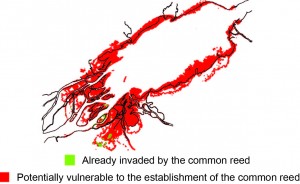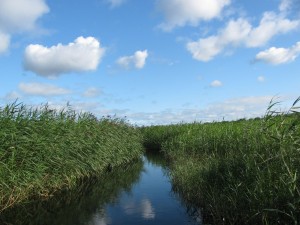Claude Lavoie, PHRAGMITES Research Group, Université Laval, Québec, Canada
January 2015
Climate warming will likely affect flooding regimes, which have a large influence on the functioning of riparian wetlands. Low water levels predicted for the St. Lawrence River wetlands make them especially vulnerable to further expansion of the invasive common reed (Phragmites australis).
The PHRAGMITES Research Group (Marie-Andrée Tougas-Tellier, Daniel Hatin and Claude Lavoie) collaborated with Environment Canada (Jean Morin) to develop a habitat model to simulate the distribution of the common reed in the St. Lawrence River under current climate conditions, and under two climate change scenarios (HadCM3 A1FI = +4 °C; CGCM2 A21 = + 3 °C) simulated for 2050.
The basic assumption of our model is that new common reed stands arise from seed germination. We gathered historical and recent (remote sensing) data on the distribution of common reed stands for model calibration and validation purposes. We then determined the parameters controlling the species establishment, such as soil exposure and temperature conditions, vegetation competition, land use, etc. An ecohydrological model and the identified parameters were used to simulate the current (2010) and the future (2050) distribution of the plant.
Common reed stands are not widespread along the St. Lawrence River (212 hectares), but our model suggests that current climate conditions are already conducive to considerable further expansion (> 16 000 hectares).
Climate change may also exacerbate the expansion, particularly if river water levels drop, which will expose large bare areas favorable to seed germination. This phenomenon may be particularly important in one sector of the river (Lake Saint-Pierre – see figure), where existing common reed stands could increase their areas by a factor of 100, potentially creating the most extensive reedbed complex in North America.

FIGURE: Spatial distribution of common reed (Phragmites australis) stands identified in Lake Saint-Pierre (St. Lawrence River) by remote sensing images (2010), and modeled spatial distribution of potential common reed habitats that have not yet been invaded for a climate change scenario (warmer and drier climate predicted for 2050).
Another model of common reed expansion in a context of future climate change has recently been published for the Great Lakes coastal zone (Carlson Mazur et al., 2014: Aquatic Invasions, 9, 1–19). Results are difficult to compare, because the scale and methods are completely different, but this model also predicts a substantial increase (from 3 600 to 13 000 km2) by 2050 of the area suitable for the common reed, in a scenario where winters will become warmer and wetter. Water level changes were not specifically addressed, but the model suggests that common reed stands will likely expand in areas with low bathymetric slope, areas presumably corresponding to the shallowest sectors of the lakes. In both models, climate change is not a prerequisite for common reed expansion, but will probably accelerate the invasion, especially given that the species readily acclimatizes to rising temperatures and higher CO2 levels.
The impacts of such expansion on biodiversity are difficult to predict, but are likely to be highly deleterious given the competitiveness of the common reed and the biological richness of freshwater wetlands.

